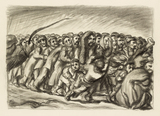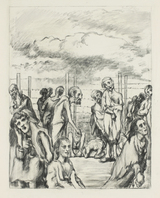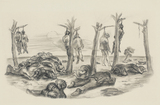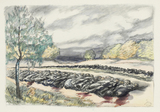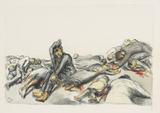Ludwig Meidner, Gas Chamber, 1942-45
Ludwig Meidner, Gas Chamber, 1942-45
As far as is known, the trains were despatched to three localities – Tremblinka [!], Belzec and Sobibor, to what the reports describe as "Extermination camps." The very method of transport was deliberately calculated to cause the largest possible number of casualties among the condemned Jews. It is reported that on arrival in camp the survivors were stripped naked and killed by various means, including poison gas and electrocution.
"The Extermination of Jews in German Occupied Poland" - Note addressed to the Governments of the United Nations on December 10th, 1942 and other documents, Published on behalf of the Polish Ministry of Foreign Affairs, London e.a. 1942
Meidner’s charcoal drawing was probably produced prior to the spring of 1945. Following the liberation of the extermination camps, numerous photos and eye-witness accounts circulated documenting the fact that in the majority of the death camps the gas chambers were disguised as shower blocks, complete with shower heads, in order to prevent panic among those being sent to their deaths. This detail, intriguing in its perfidy, does not appear in Meidner’s depiction, suggesting that the drawing was produced before such photos and accounts were published.
Further reading:
Shulamith Behr, Ludwig Meidner: Exil, Kreativität und Holocaustbewusstsein, in: Horcher in die Zeit. Ludwig Meidner im Exil (exhibition catalog Museum Giersch der Goethe-Universität, Frankfurt am Main), Munich 2016, pp. 148-161.
Kathrin Hoffmann-Curtius: Bilder zum Judenmord. Eine kommentierte Sichtung der Malerei und Zeichenkunst in Deutschland von 1945 bis zum Auschwitz-Prozess, in Zusammenarbeit mit Sigrid Philipps, Marburg 2014.


